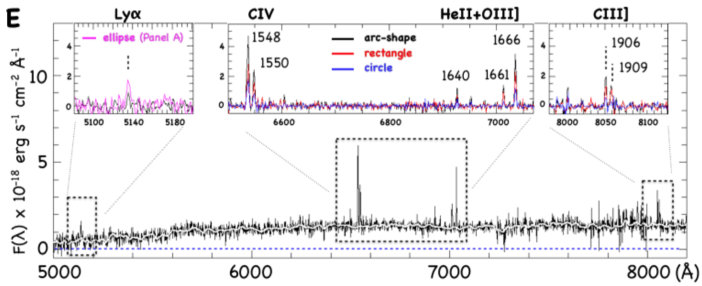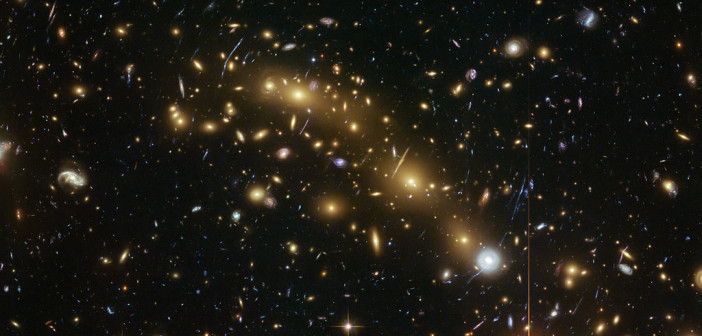Editor’s note: Astrobites is a graduate-student-run organization that digests astrophysical literature for undergraduate students. As part of the partnership between the AAS and astrobites, we repost astrobites content here at AAS Nova once a week. We hope you enjoy this post from astrobites; the original can be viewed at astrobites.org!
Title: Magnifying the Early Episodes of Star Formation: Super-star clusters at Cosmological Distances
Authors: E. Vanzella et al.
First Author’s Institution: INAF–Osservatorio Astronomico di Bologna
Status: Submitted to ApJL, open access
Have another look at the cover image, which depicts the Hubble Frontier Fields of the galaxy cluster MACS J0416. It always amazes me to see the manifestation of gravitational lensing in deep Hubble images — light from very-far-away galaxies being magnified and stretched into arcs by the strong gravity of the quite-far-away galaxy clusters. The gravity of the galaxy clusters acts as a “natural telescope” that focuses light to reveal background galaxies, which otherwise are too faint to be seen.
Astrophysicists have been puzzling over the mystery of reionization. How did reionization occur and what sources caused it? To try to answer these questions we need to know the origins and the properties of the early, far-away galaxies that were responsible. Recently, it was found that the huge number of faint galaxies may provide enough photons to reionize the universe. The technique of gravitational lensing comes in very handy because it allows far-away and faint objects to be observed!
Directly observing galaxies during reionization (with redshift z > 6) is hard. They are extremely faint and the strong characteristic spectral lines lie outside the limits of our detectors (no worries, JWST will come to rescue!) One way astrophysicists get around this problem is to study objects with slightly lower redshifts at z ~ 3, which are the younger analogs of the sources that reionized the universe. Today’s paper follows this approach.
Typically gravitational lensing reveals far-away galaxies. Today’s story is extraordinary: the authors managed to unravel two star clusters at redshift z = 3.2 by the lensing technique, and derived important hints about the ionization history of the universe.

Figure 1. HST color image of the galaxy cluster MACS J0416 (middle section of the cover image.) The insets show the six images of the object ID14 (marked a to f). The annotated numbers are the magnitudes of each component. [Adapted from Vanzella et al. 2017]

Figure 2. Spectra of ID14 taken by the MUSE instrument of the Very Large Telescope. The colors of the spectra denote contributions from different images (black is sum of ID14a, b, and c; red is ID14b and c; blue is ID14a only). The main features are the strong metal lines and the weak Lyman-alpha line. [Adapted from Vanzella et al. 2017]

Figure 3. Image showing the Lyman-alpha emitting cloud (magenta ellipse) near ID14a, b, and c (black arc). The separation is estimated to be ~2 kpc. [Adapted from Vanzella et al. 2017]
It is intriguing to see star clusters so far away. What’s more? ID14 also hints at the structure of ionizing radiation in the early universe! With the observed Hβ spectral line (not shown, see Figure 3 of the original paper), the Lyman-alpha line is predicted to be >150 times brighter than currently observed. Such deficiency can be explained by (1) dust absorption and (2) Lyman-alpha photons being scattered out of the observer’s line of sight by irregular distributions of gas. The authors proposed a plausible picture where ionizing radiation escapes the star clusters and hits the neutral cloud nearby, where we see the Lyman-alpha emission in fluorescence (Figure 3). This finding suggests that direction-dependent visibility of ionizing radiation observed on galactic scales could also prevail on the scale of star clusters.
We astrophysicists are cosmic detectives. By combining our advanced telescopes with the natural gravitational lenses, we are able to grasp information that would otherwise be out of reach. Today’s story highlights that reionization is really an incredibly complex problem, one that connects tiny star clusters to the scale of the cosmos. More and better observations will further constrain the properties of the ionizing sources and help us uncover the process of reionization!
About the author, Benny Tsang:
I am a graduate student at the University of Texas at Austin working with Prof. Milos Milosavljevic. Using Texas-sized supercomputers and computer simulations, I focus on understanding the effects of radiation from stars when massive star clusters are being assembled. When I am not staring at computer screens, you will find me running around Austin, exploring this beautiful city.


1 Comment
Pingback: reionization observed with star cluster that are gravitational lensed